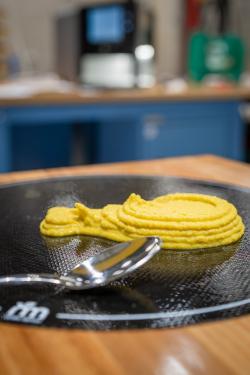Speech pathologist and researcher Professor Bronwyn Hemsley says “people with swallowing disorders often face the danger of choking on food, which can be fatal. So, to make food easier to eat, some people need it to be soft or even pureed – at which point the look and feel of the food can change, affecting the person’s appetite and quality of life.”
At the University of Technology Sydney (UTS), Professor Hemsley’s team are looking at ways that 3D printing of food could be used to improve the visual appeal of puree and to understand the impact of 3D food printing on both quality of life and mealtime safety. The researchers will also look at the usability of 3D printed food by people who have not only a swallowing disability but perhaps also physical disability or limitations in their vision, hearing or planning.
The researchers are working with a 3D food printer installed in the ProtoSpace Lab at UTS’s Sydney campus which uses real pureed food as the “ink”. The process involves first cooking the puree meal, using it to fill the printer’s cartridges, selecting the shape to be printed and pressing “play” for it to start printing, Professor Hemsley explains.
It’s important to know whether 3D food printing could increase a person’s engagement with the shape of their food, and whether or not it’s an improvement to other ways of presenting puree food, she says.
“Perhaps it would increase their involvement in mealtime food design. Having more choice and control over the food to be printed, including its colour, flavour and shape, might just make a difference to someone who can’t change the texture and must have a puree food to be safe in swallowing.
“But we don’t know yet whether people with swallowing disability would want to take part in 3D food printing, the supports they’d need, whether they’d use it, and what benefits they expect. We need to know this and also to find ways that we can make 3D printing more accessible to more people if it’s going to help to improve their lives.”
The benefits of producing “safe” food that looks good and tastes great could go beyond the nutritional, the researchers say. Social activities are often based around food and swallowing disorders can exclude people from eating out with others, Professor Hemsley says, for fear of choking or because the food looks unsightly.
“We want to see what people with swallowing disorders think about this possibility of using 3D printing,” Professor Hemsley says of the research project. “This will help us to understand how it could impact on their lives and give them more choice and control, while also increasing their mealtime safety and enjoyment.”
Remember, you can post free of charge job opportunities in the AM Industry on 3D ADEPT Media or look for a job via our job board. Make sure to follow us on our social networks and subscribe to our weekly newsletter : Facebook, Twitter, LinkedIn & Instagram ! If you want to be featured in the next issue of our digital magazine or if you hear a story that needs to be heard, make sure to send it to contact@3dadept.com






